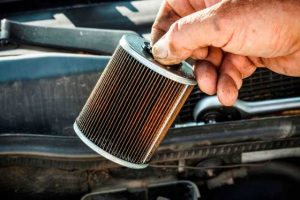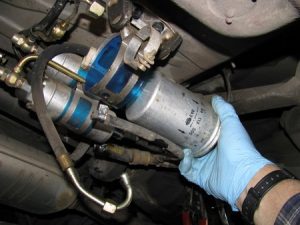How To Change A Fuel Filter
 Changing the fuel filter on a fuel-injected car isn’t always simple. Fuel-injected cars require that the fuel pump be disabled before you relieve the lines’ pressure and move on to the fuel filter replacement. Before beginning, it is important to ask your local mechanic or contact your local repair shop to help you determine the types of filer and lined that are on your vehicle and if any special tools are required.
Changing the fuel filter on a fuel-injected car isn’t always simple. Fuel-injected cars require that the fuel pump be disabled before you relieve the lines’ pressure and move on to the fuel filter replacement. Before beginning, it is important to ask your local mechanic or contact your local repair shop to help you determine the types of filer and lined that are on your vehicle and if any special tools are required.
Disconnecting the Fuel Line
Before you disconnect the fuel line, you’ll need to relieve the pressure. In order to do this, you’ll need to deactivate the electric pump prior to starting the engine. To do so, follow these steps:
- Turn the engine off.
- Open the fuse box and remove the pump’s fuse. Check the owner’s manual to determine where this fuse is located.
- Double-check that the brake is on and that the vehicle is either in neutral or park.
- Start the engine. The car won’t run for long, but this will effectively reduce the pressure.
- Turn off the engine.
- Disconnect the battery cable to prevent any accidental sparks or arcs from the battery.
Now that the fuel pump is disabled, you can continue on to disconnecting the fuel lines. The lines may be connected to the filter with clamps, quick-connect fittings or threaded fittings. If the lines use threaded fittings, you’ll need a specialty wrench for flare-nuts. If the lines have quick-connect fittings, you could also need a special tool in order to disconnect them. Remember, the best thing to do is to first ask at your local mechanic to determine the type of lines and air filter your car has. If you will have to purchase specialty tools, you may be better off hiring a mechanic or specialist to replace the filter.
How to Change a Fuel Filter
 1. Locate the filter. If you can’t find the fuel filter, refer to the owner’s manual. You’ll also be able to determine if your vehicle has more than one filter. If you don’t own a manual, ask the clerk at your local auto parts store for help or try to access the manual either online or at a library. For most fuel-injection vehicles, the fuel filter can be found somewhere along the high pressure line, which is located underneath the vehicle, close to the fuel tank. Alternatively, it could be located underneath the hood, near the engine. Certain vehicles have the fuel filter located in the fuel pump, along with a filter screen that’s inside the fuel tank. The fuel line might also be located running against the frame rails underneath on some cars.
1. Locate the filter. If you can’t find the fuel filter, refer to the owner’s manual. You’ll also be able to determine if your vehicle has more than one filter. If you don’t own a manual, ask the clerk at your local auto parts store for help or try to access the manual either online or at a library. For most fuel-injection vehicles, the fuel filter can be found somewhere along the high pressure line, which is located underneath the vehicle, close to the fuel tank. Alternatively, it could be located underneath the hood, near the engine. Certain vehicles have the fuel filter located in the fuel pump, along with a filter screen that’s inside the fuel tank. The fuel line might also be located running against the frame rails underneath on some cars.
2. Check out both filters, the new and the old. Do this before disconnecting anything. There should be an arrow on both filters. This arrow shows the direction in which the fuel flows. If the new filter doesn’t have an arrow, take note of which way the current filter is pointing so that you can determine how the new filter fits in. Taking a picture of the complete setup with a camera or your phone might help you remember how to put everything back the way it was.
3. Remove the mechanism that holds the filter and remove the filter itself. Make sure to do this carefully so that you don’t break the mechanism.
4. Attach the new filter, making sure to place it in the right position, referring to the old filter.
5. Replace the mechanism to keep the filter secure. Make sure that the filter is in tightly.
6. Replace the fuel pump fuse in the fuse box.
7. Re-connect the battery cable.
8. Check that the car is either in neutral or park. Start the engine and make sure that there aren’t any leaks.
If you’re unsure of how to locate the fuel filter or how to detach the lines, or if the filter screen in the fuel tank is blocked, it’s best to have a professional change the fuel filter. Attempting to do work on your car without the proper knowledge could lead to more of an expense to fix any problems you create.





